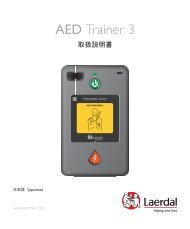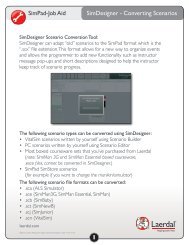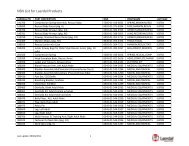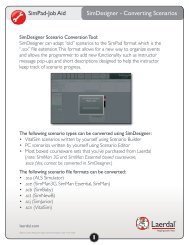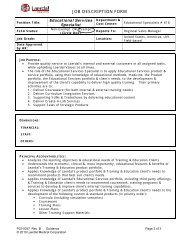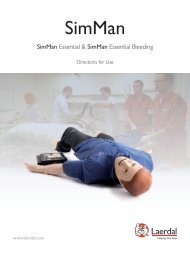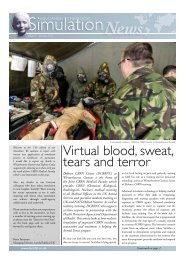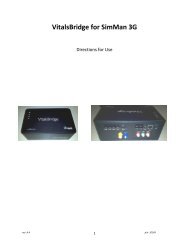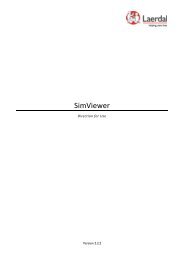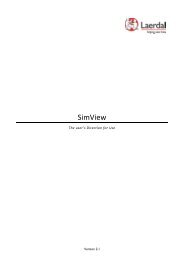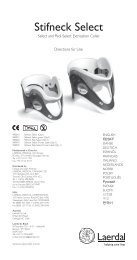HeartCode® ACLS - Net
HeartCode® ACLS - Net
HeartCode® ACLS - Net
You also want an ePaper? Increase the reach of your titles
YUMPU automatically turns print PDFs into web optimized ePapers that Google loves.
HeartCode ®<br />
<strong>ACLS</strong><br />
Contents<br />
Response............................................ 2<br />
Airway................................................. 2<br />
Breathing............................................ 6<br />
Circulation.......................................... 9<br />
Examine............................................ 13<br />
Drugs & Manage IV/IO....................... 15<br />
Lab.................................................... 16<br />
Diagnostics....................................... 17<br />
Misc.................................................. 18<br />
Other Actions.................................... 20<br />
Transfer Patient................................ 21
HeartCode ®<br />
<strong>ACLS</strong><br />
Response<br />
Icon<br />
Definition<br />
Tap and shout<br />
Checks for response by tapping and shouting to<br />
determine the level of consciousness.<br />
Check for normal breathing<br />
Determines if the patient is breathing normally by<br />
observing chest movement.<br />
Check carotid pulse<br />
Performs a pulse check at the carotid artery. The<br />
rescuer feels for a pulse for at least 5 seconds but<br />
no more than 10 seconds.<br />
Airway<br />
Icon<br />
Definition<br />
Head tilt–chin lift<br />
Performs a head tilt–chin lift. This relieves airway<br />
obstruction caused by the tongue blocking the airway.<br />
Inspect mouth<br />
Inspects mouth visually for potential foreign bodies or<br />
other obvious obstructions.<br />
2
HeartCode ®<br />
<strong>ACLS</strong><br />
Suction<br />
Performs suction of upper airway and airway adjuncts<br />
to remove secretions.<br />
Oropharyngeal airway<br />
Inserts an oropharyngeal airway to improve patency of<br />
the upper airway.<br />
Nasopharyngeal airway<br />
Inserts a nasopharyngeal airway to improve patency of<br />
the upper airway.<br />
Menu: Advanced airways<br />
Presents options for advanced airway adjuncts.<br />
Endotracheal tube<br />
Inserts endotracheal tube to improve patency of<br />
the airway.<br />
Esophageal-tracheal tube<br />
Inserts esophageal-tracheal tube to improve patency of<br />
the airway.<br />
3
HeartCode ®<br />
<strong>ACLS</strong><br />
Laryngeal mask airway<br />
Inserts laryngeal mask airway to improve patency of<br />
the airway.<br />
Check tube<br />
Checks the position of the endotracheal tube.<br />
Withdraw tube<br />
Adjusts the insertion depth of the endotracheal tube.<br />
Use EDD<br />
Checks the position of the endotracheal tube by using<br />
an esophageal detection device.<br />
Secure tube<br />
Secures the placement of the tube with tape.<br />
Tube holder<br />
Secures the placement of the tube with a commercial<br />
tube holder.<br />
4
HeartCode ®<br />
<strong>ACLS</strong><br />
Colorimetric CO 2<br />
detector<br />
Detects exhaled CO 2 by colorimetry.<br />
Attach capnometer<br />
Attaches a dynamic CO 2 detector/capnograph.<br />
Menu: Auscultate<br />
Presents options for auscultation.<br />
Two ventilations<br />
Gives 2 ventilations with a self-inflating bag.<br />
5-point auscultation<br />
Listens to heart, lungs, and abdomen.<br />
5
HeartCode ®<br />
<strong>ACLS</strong><br />
Breathing<br />
Icon<br />
Definition<br />
Check for normal breathing<br />
Determines if the patient is breathing normally by<br />
observing chest movement.<br />
Ventilate<br />
Gives continuous ventilations with a self-inflating bag.<br />
Attach pulse oximeter<br />
Measures the oxygen saturation of the peripheral<br />
arterial blood and the peripheral pulse rate.<br />
Attach capnometer<br />
Attaches a dynamic CO 2 detector/capnograph.<br />
Needle decompression<br />
Punctures the pleural cavity to deflate potential tension<br />
pneumothorax.<br />
6
HeartCode ®<br />
<strong>ACLS</strong><br />
Menu: Supplementary oxygen<br />
Presents options for different oxygen supplements.<br />
Nasal cannula<br />
Places a nasal cannula on the patient, allowing for<br />
increased oxygen supply.<br />
Simple oxygen mask<br />
Places a simple oxygen mask on the patient, allowing<br />
for increased oxygen supply.<br />
Nonrebreathing mask<br />
Places a nonrebreathing mask on the patient, allowing<br />
for increased oxygen supply.<br />
T-piece<br />
Places a T-piece on the endotracheal tube, allowing for<br />
spontaneous breathing and oxygen supply.<br />
Oxygen mask with nebulizer<br />
Places an oxygen mask with nebulizer reservoir on<br />
the patient, allowing for increased oxygen supply and<br />
nebulized drug administration.<br />
7
HeartCode ®<br />
<strong>ACLS</strong><br />
Warm and humidify oxygen<br />
Administers warm humidified oxygen to the patient.<br />
Menu: Auscultate<br />
Presents options for auscultation.<br />
Two ventilations<br />
Gives 2 ventilations with a self-inflating bag.<br />
5-point auscultation<br />
Listens to heart, lungs, and abdomen.<br />
Menu: Chest tube<br />
Presents options for placement of a chest tube.<br />
Insert chest tube<br />
Places a chest tube in the pleural cavity.<br />
8
HeartCode ®<br />
<strong>ACLS</strong><br />
Check chest tube<br />
Checks the placement of the chest tube by inspecting<br />
the site of insertion.<br />
Circulation<br />
Icon<br />
Definition<br />
Check carotid pulse<br />
Performs a pulse check at the carotid artery. The<br />
rescuer feels for a pulse for at least 5 seconds but<br />
no more than 10 seconds.<br />
CPR 30:2<br />
Performs CPR with cycles of 30 chest compressions<br />
and 2 ventilations.<br />
(Press button again to stop compressions.)<br />
Continuous CPR<br />
Performs chest compressions at 100 compressions<br />
per minute continuously without pauses for ventilation.<br />
Meanwhile you should set the ventilation and oxygen<br />
rates delivered by the other provider (preferably 8 to 10<br />
breaths per minute with high-flow oxygen).<br />
Check radial pulse<br />
Checks the peripheral pulse rate at the radial artery.<br />
9
HeartCode ®<br />
<strong>ACLS</strong><br />
Switch providers<br />
Causes the rescuers to switch positions when CPR is<br />
stopped, to prevent rescuer fatigue and maintain an<br />
adequate compression rate and depth.<br />
Place backboard<br />
Places a rigid backboard to improve the quality of chest<br />
compressions.<br />
Valsalva maneuver<br />
The patient performs the Valsalva maneuver to increase<br />
vagal tone.<br />
Carotid sinus massage<br />
Performs carotid sinus massage. This increases the<br />
vagal tone and might reduce the heart rate.<br />
Menu: Blood pressure<br />
Presents options for measuring the blood pressure of<br />
the patient.<br />
Capillary refill time<br />
Checks the capillary refill time of the patient.<br />
10
HeartCode ®<br />
<strong>ACLS</strong><br />
Manual blood pressure<br />
Measures the blood pressure of the patient manually.<br />
Set up automatic NIBP<br />
Initiates automatic noninvasive blood pressure (NIBP)<br />
measurement.<br />
NIBP interval<br />
Sets the time interval for repeated automatic NIBP<br />
measurement.<br />
Remeasure NIBP<br />
Listens to heart, lungs, and abdomen.<br />
Menu: Auscultate<br />
Presents options for auscultation.<br />
Two ventilations<br />
Gives 2 ventilations with a self-inflating bag.<br />
11
HeartCode ®<br />
<strong>ACLS</strong><br />
5-point auscultation<br />
Listens to heart, lungs, and abdomen.<br />
Menu: ECG & Defibrillator<br />
Presents options for various electrophysiologic<br />
interventions and cardiac monitoring options.<br />
Attach pads<br />
Opens a detailed view of the patient’s bare chest where<br />
you can apply the AED pads by dragging them to the<br />
correct position.<br />
Attach 3-lead ECG<br />
Attaches 3-lead ECG monitor.<br />
Change ECG display lead<br />
Changes the ECG lead displayed on the monitor.<br />
Stand clear<br />
Gives a verbal warning to stay clear of the patient.<br />
Any rescuers in contact with the victim will stop<br />
touching the victim.<br />
12
HeartCode ®<br />
<strong>ACLS</strong><br />
Obtain 12-lead ECG<br />
Presents recorded 12-lead ECGs of the patient.<br />
Check electrodes<br />
Checks the placement of the ECG electrodes.<br />
Examine<br />
Icon<br />
Definition<br />
Check the skin<br />
Checks the condition of the patient by inspecting<br />
clinical signs of the skin.<br />
Check NIH scale<br />
NIH<br />
Performs complete National Institutes of Health Stroke<br />
Scale (NIHSS) neurologic assessment of the patient.<br />
Check CPSS<br />
Performs Cincinnati Prehospital Stroke Scale (CPSS)<br />
neurologic evaluation of the patient.<br />
13
HeartCode ®<br />
<strong>ACLS</strong><br />
Measure temperature<br />
Measures the temperature of the patient with an<br />
ear probe.<br />
Continuous temperature<br />
Continuously measures the temperature of the patient<br />
with a rectal probe.<br />
Menu: Examine eyes<br />
Presents options for examining the eyes of the patient.<br />
Test eye movement<br />
Checks the eye movements of the patient.<br />
Test pupil responsiveness<br />
Checks the pupillary light reflex of the patient.<br />
Eyelash and cornea reflex<br />
Checks the ciliary and/or corneal reflex of the patient.<br />
14
HeartCode ®<br />
<strong>ACLS</strong><br />
Menu: Head-to-toe examination<br />
Allows for full body clinical examination, including<br />
findings from inspection and palpation of the different<br />
regions of the body.<br />
Menu: Auscultate<br />
Presents options for auscultation.<br />
Two ventilations<br />
Gives 2 ventilations with a self-inflating bag.<br />
5-point auscultation<br />
Listens to heart, lungs, and abdomen.<br />
Drugs & Manage IV/IO<br />
Icon<br />
Definition<br />
Administer drugs<br />
Presents the various drugs and fluids available for<br />
treating the patient.<br />
15
HeartCode ®<br />
<strong>ACLS</strong><br />
Manage IV/IO<br />
Presents options for placing intravenous (IV) and/or<br />
intraosseous (IO) cannulas at different sites.<br />
Flush IV/IO<br />
Flushes the IV/IO with a 5 mL bolus of saline.<br />
Lab<br />
Icon<br />
Definition<br />
View lab results<br />
Allows you to study the results of the blood tests<br />
ordered.<br />
Arterial puncture<br />
Performs arterial blood gas test. The results are<br />
returned in the medical record after a short while.<br />
Venous blood sample<br />
Collects venous blood samples. The results are<br />
returned in the medical record after a short while.<br />
16
HeartCode ®<br />
<strong>ACLS</strong><br />
Troponin test<br />
Checks the troponin (I/T) level of the blood. The result<br />
is returned as positive or negative in the medical record<br />
after a short while.<br />
Measure glucose<br />
Checks the capillary glucose level.<br />
Diagnostics<br />
Icon<br />
Definition<br />
View diagnostics results<br />
Presents results of the diagnostics performed during<br />
simulation.<br />
X-ray<br />
Performs on-site chest x-ray.<br />
CT scan<br />
Transports the patient to a CT scanner to perform a<br />
CT scan of the brain. The simulation is fast-forwarded<br />
during the procedure.<br />
17
HeartCode ®<br />
<strong>ACLS</strong><br />
Fibrinolytic checklist<br />
Fibrinolytic Checklist<br />
Performs a systematic workup before potential<br />
fibrinolytic administration.<br />
Obtain 12-lead ECG<br />
Presents recorded 12-lead ECGs.<br />
MISC<br />
Icon<br />
Definition<br />
Supine<br />
Places the patient in supine position.<br />
Sit up<br />
Places the patient in a sitting position.<br />
Raise legs<br />
Elevates the legs of the patient.<br />
18
HeartCode ®<br />
<strong>ACLS</strong><br />
Insert urinary catheter<br />
Places a urinary catheter in the bladder of the patient.<br />
Check catheter output<br />
Checks the urinary output from the patient.<br />
Blanket<br />
Places a blanket on the patient.<br />
Therapeutic hypothermia<br />
Begins preparation for post–cardiac arrest<br />
therapeutic hypothermia.<br />
Call MET<br />
Activates the medical emergency team by<br />
calling for help.<br />
Consult Cardiology<br />
Calls for cardiologic consultation.<br />
19
HeartCode ®<br />
<strong>ACLS</strong><br />
Consult Neurology<br />
Calls for neurologic consultation.<br />
Open Handbook<br />
Pauses the simulation and shows the BLS section of<br />
the 2010 Handbook of Emergency Cardiovascular Care<br />
for Healthcare Providers.<br />
Other actions<br />
Icon<br />
Definition<br />
Call code<br />
Activates the emergency response system, resulting in<br />
emergence of 2 additional rescuers to assist with CPR<br />
later on.<br />
Medical record<br />
Opens the medical record to review patient history,<br />
clinical signs, and lab findings obtained during the<br />
patient case.<br />
20
HeartCode ®<br />
<strong>ACLS</strong><br />
Transfer Patient<br />
Icon<br />
Definition<br />
ICU/monitored bed<br />
Ends the scenario by transferring the patient to<br />
an Intensive Care Unit or other unit with advanced<br />
monitoring.<br />
Transvenous pacing<br />
Ends the scenario by transferring the patient to a<br />
laboratory with option for invasive pacing.<br />
PCI<br />
Ends the scenario by transferring the patient to a<br />
coronary artery angiography laboratory with possibility<br />
for dilatation and stenting.<br />
Discharge<br />
Ends the scenario by discharging the patient from<br />
the hospital.<br />
Medical Ward<br />
Ends the scenario by transferring the patient to a<br />
medical ward with standard care level.<br />
21
HeartCode ®<br />
<strong>ACLS</strong><br />
Surgical Ward<br />
Ends the scenario by transferring the patient to a<br />
surgical ward.<br />
Stroke Unit<br />
Ends the scenario by transferring the patient to a<br />
stroke unit for careful observation and physiologic<br />
optimization.<br />
Stop further treatment<br />
Ends scenario by aborting all interventions and<br />
withholding further treatment.<br />
22



